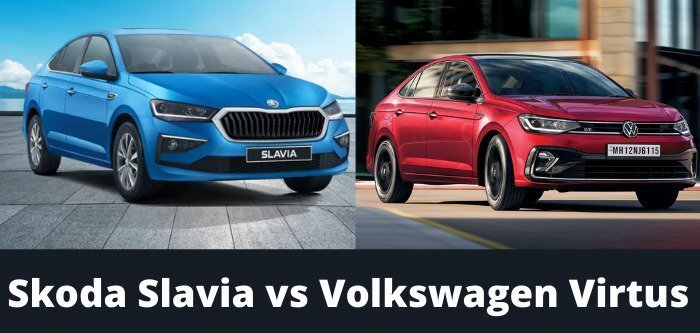
In a segment single-handedly ruled by Honda City, both Volkswagen and Skoda had a decent presence for a decade with the Vento and Rapid respectively. Come 2022, and while the City remains the segment king in terms of volumes with the latest fifth-generation version, Volkswagen and Skoda have decided to up their game with their respective all-new offerings – the Volkswagen Virtus and Skoda Slavia.
While the Virtus has replaced the Vento, the Slavia has filled in the shoes of the ageing Rapid. Like Vento and Rapid, both Virtus and Slavia are closely related to each other, sharing the same platform and powertrain options. However, this time around, both the cars have very different visual appeal in and out, which make them more different looking cars and gives them more individuality.
Here, we have compiled down all the things which are common between the Volkswagen Virtus vs Skoda Slavia, and the elements and details which differentiate both of them.
Price
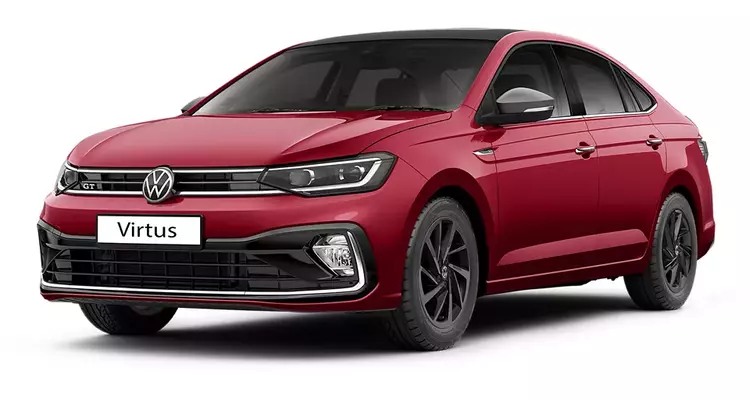
Skoda launched towards the end of February 2022, with the prices for 1.0-litre TSI variants set between Rs 10.69 lakh to Rs 15.39 lakh and 1.5-litre TSI variants priced between Rs 16.19 lakh to Rs 17.79 lakh. On the other hand, while the official prices for Volkswagen Virtus will be announced in May 2022, they are expected to be around the prices of Skoda Slavia, just like how closely Volkswagen Taigun and Skoda Kushaq are priced to each other.
ALSO READ: Porsche Taycan vs Tesla Model S
Engine and Performance

Both the Volkswagen Virtus and Skoda Slavia are identical cars under the skin. Based on the Volkswagen family’s versatile MQB A0-IN platform, which also underpins Taigun and Kushaq SUVs, the Volkswagen Virtus and Skoda Slavia are offered with two different turbocharged petrol engine options.
The first one is the 1.0-litre three-cylinder TSI petrol, which is going to be the volume driver for both the Virtus and Slavia. Available with two transmission choices of 6-speed manual and 6-speed automatic gearbox, this engine produces 115 PS of maximum power and 178 Nm of maximum torque in both sedans.
There is also a performance-oriented 1.5-litre four-cylinder TSI petrol, which has created the new performance benchmark in the premium compact sedan category. This engine is offered with both 6-speed manual and 7-speed dual-clutch automatic transmission options in both cars and produces maximum power and torque outputs of 150 PS and 250 Nm respectively.
| Specifications |
Skoda Slavia |
Volkswagen Virtus |
| Engine |
1.0-litre three-cylinder TSI petrol / 1.5-litre four-cylinder TSI petrol |
1.0-litre three-cylinder TSI petrol / 1.5-litre four-cylinder TSI petrol |
| Power |
115 PS @ 5,000 rpm / 150 PS @ 5,000 rpm |
115 PS @ 5,000 rpm / 150 PS @ 5,000 rpm |
| Torque |
178 Nm @ 1,750 rpm / 250 Nm @ 1,600 rpm |
178 Nm @ 1,750 rpm / 250 Nm @ 1,600 rpm |
| Gearbox |
6-speed manual and 6-speed automatic / 6-speed manual and 7-speed DCT |
6-speed manual and 6-speed automatic / 6-speed manual and 7-speed DCT |
Exterior and Dimension
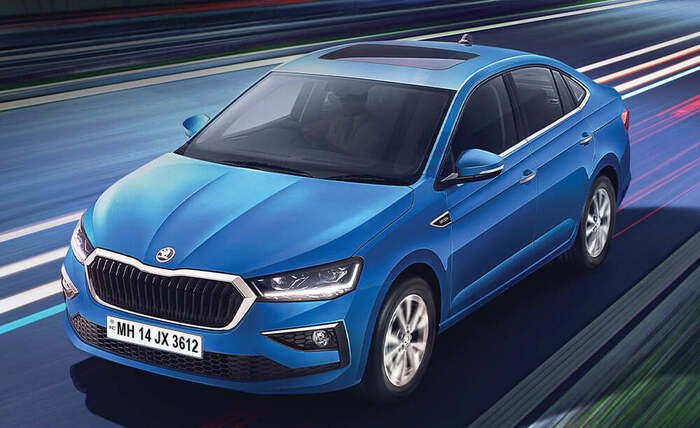
It is a very rare instance when two cars are identical when it comes to dimensions. This rare theory has been proven by both Volkswagen Virtus and Skoda Slavia. Both these cars share the exact length, width, height, wheelbase, boot space, ground clearance and fuel tank capacity.
| Dimensions |
Skoda Slavia |
Volkswagen Virtus |
| Length |
4541 mm |
4541 mm |
| Width |
1752 mm |
1752 mm |
| Height |
1487 mm |
1487 mm |
| Wheelbase |
2651 mm |
2651 mm |
| Boot space |
521 litres |
521 litres |
| Ground clearance |
179 mm |
179 mm |
| Fuel tank capacity |
45 litres |
45 litres |
Exterior Design and Features
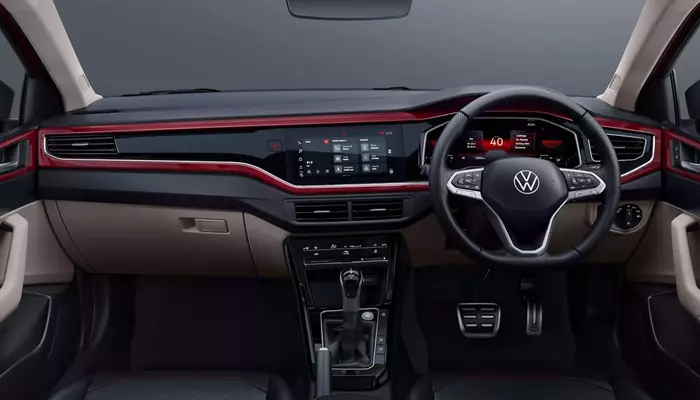
It is where the differences between both the cars are much more prominent than in any other aspect. Both the Volkswagen Virtus and Skoda Slavia look entirely different and follow their respective carmaker’s latest design philosophies.
The Volkswagen Virtus replaces the Vento and takes forwards the design of the latter in a sharper and sleeker manner. At the front, the Virtus gets a sleeker grille and slim headlamps, which are all-LED units with L-shaped daytime running LEDs. On the other hand, the Skoda Slavia has a more aggressive-looking front fascia, with a hexagonal grille with vertical slats and bigger LED headlamps with L-shaped daytime running LEDs. The front profile of the Slavia has a more prominent use of chrome compared to that in the Virtus.
Coming to the side profile, both the cars have a near-identical side look including a couple of sharp creases and window waistline, with the latter having a chrome finish on it. Both the cars here are equipped with 16-inch machined alloy wheels, with different patterns for spokes in both cars.
At the back, the design changes between the two cars become more apparent. Both the sedans here get LED tail lamps that look sharp and are characterized by angular edges. However, while the tail lamps of the Slavia have a crystalline 3D effect, the tail lamps of Virtus have a clear lens effect.
There’s a catch though – unlike the Skoda Slavia which has the same visual appeal for both 1.0-TSI and 1.5-TSI versions, the Volkswagen Virtus gets the 1.5-TSI in exclusive GT trims. These GT trim variants get a bit more visual highlights like red brake callipers and blacked-out rearview mirrors, roof, alloy wheels and boot-mounted slim spoiler.
ALSO READ: Audi Q5 vs BMW X3
Interior Design and Features
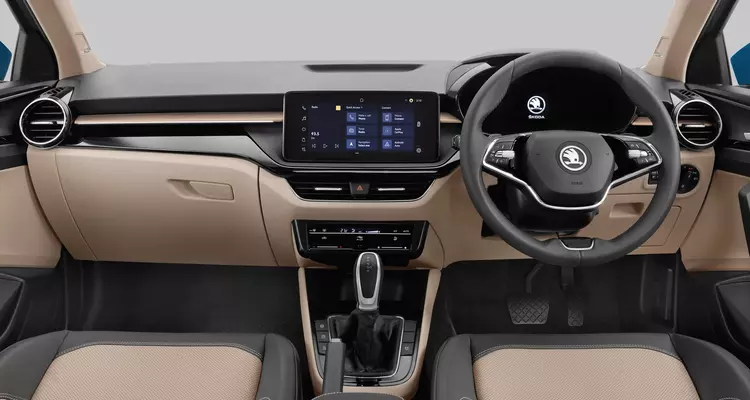
Like the exterior, the cabins of both Volkswagen Virtus and Skoda Slavia are very different from each other. Both the cabins look very much inspired by their SUV counterparts – while the cabin of the Virtus looks inspired from that of the Taigun, the Slavia seeks inspiration from the Kushaq.
While the cabin of the Virtus looks sportier and funkier with an all-black cabin with colour-coded inserts, that of the Slavia feels more elegant and airy with a dual-tone black and beige upholstery. In addition, while the centre console of the Virtus is designed with the infotainment system integrated between two layers, the Slavia has a floating effect for the infotainment system. Both the cars have different steering wheels too – while the Virtus has a three-spoke steering wheel with silver inserts, the Slavia has a more unique two-spoke steering wheel with chrome inserts.
However, many elements have been shared between both the cars, such as 7-inch full-TFT instrument console, a 10.1-inch touchscreen for the infotainment system which supports wireless Apple Carplay and Android Auto and the lower centre console which houses a touch-sensitive panel for the automatic climate control.
Other features which are common in both cars are a wireless charger, ventilated front seats, electric sunroof, height-adjustable driver’s seat, push start-stop button, multi-functional steering wheel with audio, Bluetooth and cruise control buttons, leather upholstery, rear AC vents. The safety equipment list in both the cars includes front, side and curtain airbags, ABS with EBD and brake assist, electronic differential lock, electronic stability program, hill hold assist, hill descent control and reverse parking sensors with camera.
Verdict
Barring the exterior design and dashboard layout, there is nothing much to differentiate between the Volkswagen Virtus and Skoda Slavia. Both the cars have almost the same equipment list, same platforms underpinning them and the same zestful engine and transmission options. Choose any one of the two based on your design preferences, and you can’t go wrong with either.
ALSO READ:
You must be logged in to post a comment Login